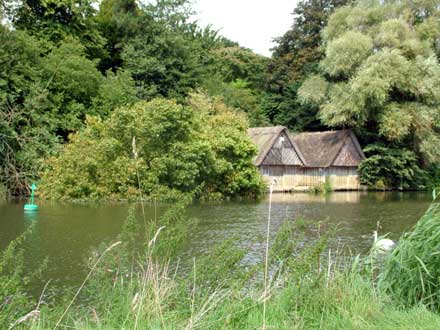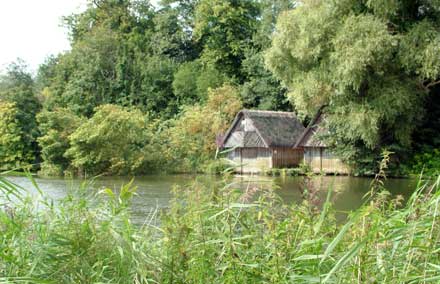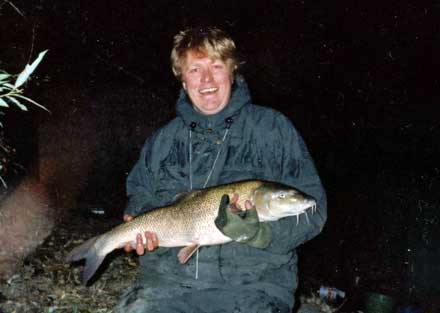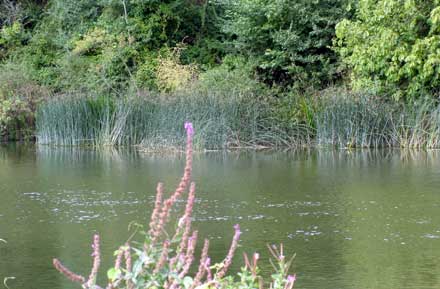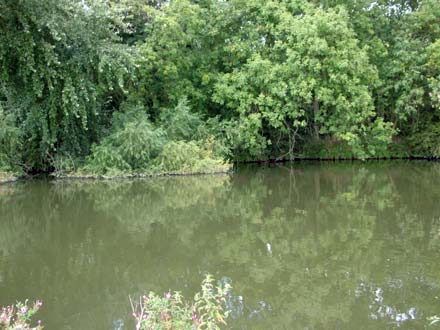If you read the angling press it is full of ‘how to’ articles ranging from how to fish the method feeder to how to fish the pole. This is a ‘how I find the fish’ article, the things I consider when looking for new swims and how I investigate likely looking places, because no matter how well you can present a maggot under a delicately shotted float if the fish aren’t there you won’t catch. The article is based around a couple of miles of the river Thames and six years of fishing it for just about every species that live there except carp. The river itself is approximately two miles long with a slow yet steady flow, it meanders through the fields of Oxfordshire with a large weir at the extreme upstream end, a second weir with a lock cut bypass and a brick road bridge crossing it lower down close to the parking area. From this stretch I will take a look at four different swims, beginning at the furthest downstream point, the boathouse. The boathouse swim from downstream
This swim is about 30yds wide, the water varies from around 3ft deep along the near bank, down to approximately 9ft in the centre, it then shallows back up to about 3ft along the far bank with a slightly deeper area in front of the boathouse itself. There are three areas that regularly produce fish in this swim; the far bank to the left of the boathouse has a succession of overhanging trees. The central channel has a clear stony bottom. The near bank has quite a large reed bed. The first time I saw this swim I was on a scouting session trying to find areas which looked promising for some reasonable sized perch. Armed only with a box of maggots, some polarised sunglasses and a catapult, I would feed a few pouches full of maggots into a likely looking swim and then look for signs of smaller bait fish as the maggots fell through the water. Perch love structure, so any reeds or underwater weed would be a likely spot as well as overhanging trees and obstructions in the water. The reedbed looked promising so I fed it a few pouches of bait, only about 20 maggots at a time with about 30 seconds between each pouchful. Within a couple of minutes I could see small dace and bleak flashing in the water about half depth. I noted this and continued on my search. The second visit I returned armed with two rods, one set up with a bobber float, the other a quiver tip. Baits were maggots and lobworms. The plan being to try the float by the reeds and a feeder over by the over hanging trees. The first thing to do after arriving was to have a thorough investigation of the whole swim. I do this by a combination of leading around to find the makeup of the bottom and plumbing the depth using a float.
With the quivertip set up I started to lead around and quite soon found that most of the bottom is covered in cabbages and streamer weed except for a small channel down the centre which was gravel. Plumbing the depth showed the slowly varying contour of the bottom with the deepest area roughly in the middle where the gravel channel is. Then I stopped the investigation and began to feed the near side with maggots again, this time only about 10 maggots were flicked in every 30 seconds or so while I kept looking for the flash of small fish down in the water. After about an hour of this, I had small fish darting backward and forward boiling the surface after the maggots, so I put on a large lobworm under the float, set it a few inches overdepth and flicked it just downstream of where I was catapulting the maggots. As I picked up the catapult to begin feeding again the float slid across the surface, bobbed a couple of times, then disappeared, after a brief fight I landed a perch of about half a pound. I fished this line a while longer but no more perch so I decided to try under the overhanging trees with the feeder. This time I used a blockend feeder filled with maggots and lobworm on the hook. As soon as I cast in the feeder settled and the tip began to tremble as small fish attracted by the maggots attacked the worm. Then suddenly the tip flew round and I then landed a chub of about 3lbs. My third visit to this swim was to investigate it’s potential for chub, bream and barbel. I would fish on into the dark using a groundbait feeder containing a fishmeal-based groundbait with corn and small red worm on the hook. The two areas that I would investigate were the overhanging trees and the gravel patch in the middle. I started by feeding balls of groundbait containing sweetcorn onto the gravel area and a couple over to the bushes. Then cast over them with the feeder, by the end of the evening I had caught 12 chub to just less than 5lbs, eight of the fish had come from over by the bushes the other four from the gravel area. Now we move a little further upstream to an area by the road bridge in search of roach, perch and pike
This area is a little wider than downstream and so does not flow quite as strongly. The view here is looking slightly upstream and across flow and the direction is from left to right. The bottom is mainly gravel on this bank with a shallow area going out about eight meters. This can be seen here in the picture as the slightly red tinge in the water at the bottom. There is a distinct channel running from this shallow area over to a couple of meters from the far bank, depth is around eight to 10ft in the channel, 3ft by the far bank and 18 inches by the near bank. The reedbed to the left of the photo is a good area for small perch, jack pike and small roach. This reedbed has around 2ft of water within the stems and it is possible to fish very close to the reeds while standing on the opposite bank. I have caught some quite large roach from this area, also in winter, by fishing over the areas where the reedbeds are in summer using bread. This isn’t always possible however because the field floods very quickly. The road bridge is always a good place to look for a few smallish chub during daytime, fishing close to the bridge legs or into the arches with the odd bonus fish occasionally being caught from the boat channels. The main areas of interest are slightly downstream to the right of the view shown. The church end reedbeds This large reedbed is broken by channels of deeper water, which run through it, and is a very good spot for catching roach and perch with the odd jack pike mixed in. The reedbed is once more the thing that drew my attention to it as a home for perch. On leading around I found the bottom is clear gravel for most of it with a small patch of cabbages just before the reedbed in the deeper area.
My first session on here produced my first Thames 2lb plus perch from the hole in the right of the reed bed, and once more to lobworm. Fishing maggot either on float tackle or feeder will produce roach and small perch. I have caught a few bream as well as the odd chub from the central channel but this is very unreliable, just downstream to the right is the next area of interest; another area of overhanging trees. Overhanging trees The overhanging trees here are another magnet for chub and the odd brown trout. My most effective method here has been maggot feeder with maggot on the hook, cast slightly upstream of the branches in the water. Or worm fished under the overhanging branches for perch. Roach can be caught along the edge of the deepest section at the bottom of the slope as it falls away on the near side. This is a good swim for stickfloat fishing because it has a relatively uniform and quite clear bottom within a couple of rod’s length from the bank. Both of the swims are predominantly summer swims but as the temperatures fall and the river levels rise the fish tend to head for more sheltered areas where respite can be gained from the flow. |
Welcome!Log into your account










